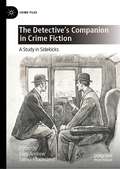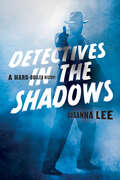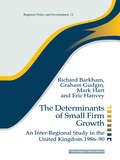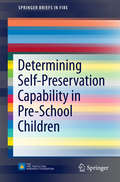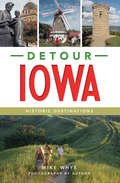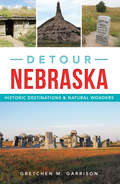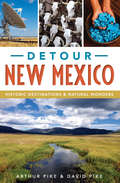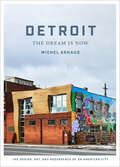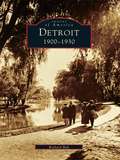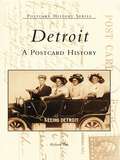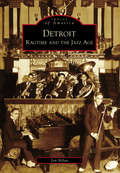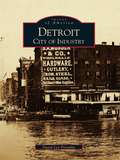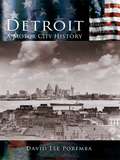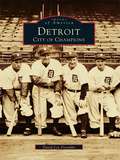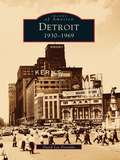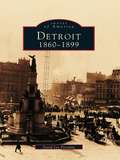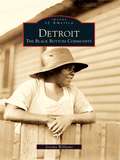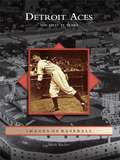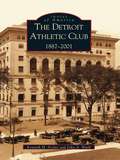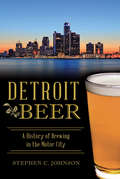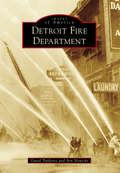- Table View
- List View
Detecting Women: Gender and the Hollywood Detective Film
by Philippa GatesFinalist for the 2012 Edgar Award in the Best Critical/Biographical Category presented by the Mystery Writers of AmericaIn this extensive and authoritative study of over 300 films, Philippa Gates explores the "woman detective" figure from her pre-cinematic origins in nineteenth century detective fiction through her many incarnations throughout the history of Hollywood cinema. Through the lens of theories of gender, genre, and stardom and engaging with the critical concepts of performativity, masquerade, and feminism, Detecting Women analyzes constructions of the female investigator in the detective genre and focuses on the evolution of her representation from 1929 to today. While a popular assumption is that images of women have become increasingly positive over this period, Gates argues that the most progressive and feminist models of the female detective exist in mainstream film's more peripheral products such as 1930's B-picture and 1970's Blaxploitation films. Offering revisions and new insights into peripheral forms of mainstream film, Gates explores this space that allows a fantasy of resolution of social anxieties about crime and, more interestingly, gender, in the 20th and early 21st centuries. The author's innovative, engaging, and capacious approach to this important figure within feminist film history breaks new ground in the field of gender and film studies.
The Detective's Companion in Crime Fiction: A Study in Sidekicks (Crime Files)
by Lucy Andrew Samuel SaundersThis book aims to establish the position of the sidekick character in the crime and detective fiction literary genres. It re-evaluates the traditional view that the sidekick character in these genres is often overlooked as having a small, generic or singular role—either to act as the foil to the detective in order to accentuate their own abilities at solving crimes, or else to simply tell the story to the reader. Instead, essays in the collection explore the representations and functions of the detective’s sidekick across a range of forms and subgenres of crime fiction. By incorporating forms such as children’s detective fiction, comics and graphic novels and film and television alongside the more traditional fare of novels and short stories, this book aims to break down the boundaries that sometimes exist between these forms, using the sidekick as a defining thread to link them together into a wider conceptual argument that covers a broad range of crime narratives.
Detectives in the Shadows: A Hard-Boiled History
by Susanna LeeA century of American history reflected in the iconic private eye.Steadfast in fighting crime, but operating outside the police force—and sometimes even the law—is the private detective. Driven by his own moral code, he is a shadowy figure in a trench coat standing on a street corner, his face most likely obscured by a tilted fedora, a lit cigarette dangling from his hand. The hard-boiled detective is known by his dark past, private pain, and powers of deduction. He only asks questions—never answers them. In his stories he is both the main character and the narrator.America has had a love affair with the hard-boiled detective since the 1920s, when Prohibition called into question who really stood on the right and wrong side of the law. And nowhere did this hero shine more than in crime fiction. In Detectives in the Shadows, literary and cultural critic Susanna Lee tracks the evolution of this truly American character type—from Race Williams to Philip Marlowe and from Mike Hammer to Jessica Jones. Lee explores how this character type morphs to fit an increasingly troubled world, offering compelling interpretations of The Wire, True Detective, and Jessica Jones. Suddenly, in the present day, the hard-boiled detective wears his—or her—fatigue outwardly, revealing more vulnerability than ever before. But the detective remains resolute in the face of sinister forces, ever the person of honor. For anyone interested in crime fiction and television, or for those wanting to understand America's idolization of the good guy with a gun, Detectives in the Shadows is essential reading.
The Determinants of Small Firm Growth: An Inter-Regional Study in the United Kingdom 1986-90 (Regions and Cities #8)
by Richard Barkham Graham Gudgin Mark HartOne of the most striking trends in economic development since the 1970s has been the rising importance of the small firm. Focusing on the issues of enterprise development and the regional dimensions of small-firm growth, this book explores the literature of this area. Moving from an analysis of measures of growth to the effects of both internal and external variables - arguing that the owner-manager has a key role in the growth performance of the firm - the authors explore regional disparities in, and constraints on, growth, and make significant advances in the policy debate on understanding how faster growth can be achieved.
Determining Self-Preservation Capability in Pre-School Children
by Anca Taciuc Anne S. DederichsThis SpringerBrief explores the evacuation characteristics of children and their self-preservation capability during fire situations. An international survey among teachers from day-care centers and experts in child development indicates an age-limit at which pre-school children may be considered capable of evacuating a location without direct intervention by an instructor. The survey examines the ability of children to understand and follow simple instructions, walk on horizontal surfaces without physical support, and walk down stairs. It also studies how fire safety installations and fire drills differ between countries. A literature review and a presentation of the method applied are included. This data can be applied to evacuation procedures, building codes, and fire regulations. Determining Self-Preservation Capability in Pre-School Children is intended for practitioners as a tool for analyzing evacuation safety issues and developing methods removing potential hazards. Researchers working in a related field will also find the book valuable.
Detour Iowa: Historic Destinations
by Mike WhyeIowa history ranges from the natural to what's been made by humans over many centuries. Find and hold the fossilized remains of sea creatures that lived 375 million years ago. Walk through a small-town home where one of the nation's most infamous--and unsolved--murders occurred in 1912. Savor pastries that originated in the Netherlands before the 1840s and watch where wheat is ground into flour in a windmill first built in Denmark and then rebuilt in Elk Horn. Listen to time softly tick away in an elaborately carved clock that auto pioneer Henry Ford tried and failed to buy in 1928 for $1 million. Join writer-photographer Mike Whye on trips to the known, little-known and unknown historic places in Iowa.
Detour Nebraska: Historic Destinations & Natural Wonders
by Gretchen M. GarrisonFor many, Nebraska is the flat prairie seen from the interstate. Yet with the Sandhills, bluffs and river valleys, the state has an abundance of riches. The heritage of early settlers is evident. Fort Kearny and Chimney Rock were pioneer harbors. The Fur Trade Museum and the Homestead Monument of America tell of those who came to make a life. Carhenge is a nationally known treasure. The Joslyn Art Museum features world-class art, and the Nebraska National Forest is the largest hand-planted forest in the nation. Native Nebraskan Gretchen Garrison details the places and people that make the Cornhusker State unique.
Detour New Mexico: Historic Destinations & Natural Wonders
by Arthur Pike David PikeNew Mexico’s rich and varied history is easily accessible via detours down obscure backroads and overlooked off-ramps. By taking the road less traveled in any direction, visitors can experience ancient landmarks, cultural heritage sites and striking vistas. Stop at places along the old Route 66, sample the world’s best chiles by the Rio Grande or soak in geothermal water flowing under Truth or Consequences. Ancient dwellings in remote canyons, the town where the first atomic bomb was secretly assembled and the grave of Billy the Kid all lie off the beaten path in the Land of Enchantment. Authors Arthur and David Pike map out these and many more worthwhile points of interest for the curious traveler.
Detoxing Masculinity in Anglophone Literature and Culture: In Search of Good Men
by Sara Martín M. Isabel SantaulàriaThis edited volume rethinks Masculinity Studies by breaking away from the notion of the perpetual crisis of masculinity. It argues that not enough has been done to distinguish patriarchy from masculinity and proposes to detox masculinity by offering a collection of positive representations of men in fictional and non-fictional texts. The editors show how ideas of hegemonic and toxic masculinity have been too fixed on the exploration of dominance and subservience, and too little on the men (and the male characters in fiction) who behave following other ethical, personal and socially accepted patterns. Bringing together research from different periods and genres, this collection provides broad, multidisciplinary insights into alternative representations of masculinity.
Detroit: The Dream Is Now
by Michel ArnaudDetroit: The Dream Is Now is a visual essay on the rebuilding and resurgence of the city of Detroit by photographer Michel Arnaud, co-author of Design Brooklyn. In recent years, much of the focus on Detroit has been on the negative stories and images of shuttered, empty buildings—the emblems of Detroit’s financial and physical decline. In contrast, Arnaud aims his lens at the emergent creative enterprises and new developments taking hold in the still-vibrant city. The book explores Detroit’s rich industrial and artistic past while giving voice to the dynamic communities that will make up its future. The first section provides a visual tour of the city’s architecture and neighborhoods, while the remaining chapters focus on the developing design, art, and food scenes through interviews and portraits of the city’s entrepreneurs, artists, and makers. Detroit is the story of an American city in flux, documented in Arnaud’s thought-provoking photographs.
Detroit: 1900-1930
by Richard BakIn this new addition to the Images of America series,Richard Bak takes us on a visual journey through Detroit's golden era, encompassing the first three decades of the twentieth century. It was during this time that the City of Detroit experienced its most rapid physical growth and underwent an unprecedented pace of social and technological change. Detroit: 1900-1930 contains nearly 190 illustrations, including studio portraits, snapshots, postcards, songsheet covers, and period advertisements. Collectively, these images evoke a past that is often too easily forgotten as older Detroiters pass away. As you thumb through the pages of this book, you will encounter such influential people as Henry Ford and other automotive pioneers who helped to "put the world on wheels." Experience daily life as it was lived at the time of the First World War, and discover the major role Detroit played in this historic conflict. This volume highlights the wave ofimmigration that occurred here at the turn of the century, when roughly half of the city's population hailed from other countries. Also featured are various scenes from the "Roaring Twenties," the ill-fated experiment in Prohibition, and the effect of the Great Depression on the city's economy.
Detroit: A Postcard History (Postcard History Series)
by Richard BakPostcard photographers traveled the length and breadth of the nation snapping photographs of busy street scenes, documenting local landmarks, and assembling crowds of neighborhood children only too happy to pose for a picture. These images, printed as postcards and sold in general stores across the country, survive as telling reminders of an important era in America's history.
Detroit: Ragtime and the Jazz Age
by Jon MilanDetroit has always been at the forefront of American popular music development, and the ragtime years and jazz age are no exception. The city's long history of diversity has served the region well, providing a fertile environment for creating and nurturing some of America's most distinctly indigenous music. With a focus on the people and places that made Detroit a major contributor to America's rich musical heritage, Detroit: Ragtime and the Jazz Age provides a unique photo journal of a period stretching from the Civil War to the diminishing years of the big bands in the early 1940s.
Detroit: City of Industry
by David Lee PorembaDetroit is known worldwide as the automotive capital of the world. What is not widely known is that, prior to the birth of the automobile, a tremendous diversity of manufactured goods transformed Detroit from a frontier town into a great industrial city. Another vital installment in a series of books about the Dynamic City, Detroit: City of Industry illustrates a slice of the city's history that is largely unknown. Through a collection of remarkable images that are among the oldest in the city, Detroit is revealed as a thriving, bustling manufacturing town that served as the world's leader in a number of important industries. Bessemer steel, iron, steel rails, freight cars, stoves, lumber, drugs, and cigars are just a few of the products that helped the city build the capital that was later needed to prosper during the automobile era. This book examines Detroit's development from the 1860s through the 1890s, and its evolution into a leading industrial center of the Midwest.
Detroit: A Motor City History
by David Lee PorembaOn July 24, 1701, Antoine de La Mothe Cadillac stood in the heart of the wilderness on a bluff overlooking the Detroit River and claimed this frontier in the name of Louis XIV; thus began the story of Detroit, a city marked by pioneering spirits, industrial acumen, and uncommon durability. Over the course of its 300-year history, Detroit has been sculpted into a city unique in the American experience by its extraordinary mixture of diverse cultures: American Indian, French, British, American colonial, and a variety of immigrant newcomers. Detroit: A Motor City History documents the major events that shaped this once-small French fur-trading outpost across three centuries of conflict and prosperity. Through informative text and a variety of imagery, readers experience firsthand the struggles of the nascent village against raiding Indian tribes and the incessant political and military tug of war between the colonial French and English, and then American interests. Like many other major cities across the United States, Detroit played a pivotal role in establishing the country's economic and industrial power in the nineteenth and twentieth centuries, serving as a center for its well-known civilian and military mass-production resources. This visual history provides insight into Detroit's rapid evolution from a hamlet into a metropolis against a backdrop of important community and national affairs: the decimating fire of 1805, the War of 1812, the Civil War, the Industrial Revolution, the Great Depression, and both world wars.
Detroit: City of Champions
by David Lee PorembaProfessional sports have played an important part in the history of the people and the City of Detroit since the turn of the century. Detroit sports teams have given the city a unique identity and provided the means to gain both a sense of community pride and a unity of spirit. At no other time was this more evident than during the decades from the 1920s through the 1950s, when Detroit teams rose consistently to the top of their individual professions. In 1935, the three professional sports teams in Detroit accomplished a remarkable feat by each winning their respective league titles and going on to capture the World Championships of baseball, football, and hockey, earning for the City of Detroit the honored sobriquet of "City of Champions." Here began a close and lasting relationship between Detroit sports teams and their fans.
Detroit: 1930-1969 (Images of America)
by David Lee PorembaAs the roaring twenties came to an end and a new decade dawned, the United States found itself locked in the grips of the Great Depression. The City of Detroit was no exception as industry laid off workers and bread lines formed across the city. Detroit Mayor Frank Murphy let the country in supporting state and federal welfare programs to help people through the economic crisis. By the middle of the 1930s, Detroit began picking itself up out of the economic mud and was soon flexing its industrial muscle as manufacturing, led by the auto industry, put the Motor City back into shape. As the decade ended and war approached, the city was ready to take its place on the world stage. The country reeled from the shock of the attack on Pearl Harbor and had to shift its industrial might from civilian use to the war effort. Nowhere was that more evident than in Detroit. Its huge manufacturing capabilities, when turned to the making of the implements of war, earned the city a new nickname. The Motor City became to the Arsenal of Democracy and began to evolve once more. The influx of workers from the Deep South to the war industry added yet another facet to the city's society and culture. As the Second World War came to a close and production re-tooled for the return to civilian life, an economic boom swept through Detroit. The city celebrated its 25oth birthday in 1951, prompting an outpouring of funds to build with. Major additions were made to the Art Institute, the Detroit Historical Museum, and the riverfront.
Detroit: 1860-1899 (Images of America)
by David Lee PorembaIn this rare and unprecedented collection, discover Detroit as it once was, with the people and industries that flourished in this community prior to the twentieth century. With over 230 photographs, Detroit 1860-1899 encompasses a visual history of the city before the birth of the automobile industry. Join Mr. Poremba on a trip down memory lane to the beginnings of the "Motor City." Witness its growth and change, and its lasting contributions to our nation's history. Detroit 1860-1899 will be enjoyed by young and old, resident and visitor alike.
Detroit: The Black Bottom Community (Images of America)
by Jeremy WilliamsBetween 1914 and 1951, Black Bottom's black community emerged out of the need for black migrants to find a place for themselves. Because of the stringent racism and discrimination in housing, blacks migrating from the South seeking employment in Detroit's burgeoning industrial metropolis were forced to live in this former European immigrant community. During World War I through World War II, Black Bottom became a social, cultural, and economic center of struggle and triumph, as well as a testament to the tradition of black self-help and community-building strategies that have been the benchmark of black struggle. Black Bottom also had its troubles and woes. However, it would be these types of challenges confronting Black Bottom residents that would become part of the cohesive element that turned Black Bottom into a strong and viable community.
Detroit Aces: The First 75 Years (Images of Baseball)
by Mark RuckerEver since the city was granted its first major league team, the Wolverines in 1881, Detroit baseball fans have packed the parks to loyally cheer for their favorite hurlers on the mound. In 1887, Charlie Getzein, nicknamed "Pretzels," led the Detroit ball club to its first National League pennant with 29 wins. The rubber-armed "Wild" Bill Donovan led the Detroit Tigers to the city's first American League pennant in 1907, notching up an astounding .862 winning percentage despite a legendary lack of control. More great pitchers were to follow in the coming decades, and, written from the perspective of an old-time fan, Detroit Aces: The First 75 Years is a fun read for any Motor City baseball enthusiast.
Detroit Area Test Tracks (Images of America)
by Michael W. DavisThe catastrophic failure of a new but unproven copper-cooled Chevrolet in 1923 led the General Motors Corporation to buy back the 100 cars it had sold to the public and recall another 400 in company and dealer hands. As a result, in 1924 General Motors started building the industry's first scientific proving ground to test new vehicle designs before they were released for production and sale. Before this, all automakers tested new cars haphazardly on public roads and within limited engineering laboratories. Better known by the public as test tracks, the proving grounds became a source of curiosity for decades about the secrets they might hold. Detroit Area Test Tracks goes behind the test track walls to show how the facilities evolved and what typically takes place inside.
Detroit Athletic Club, The: 1887-2001 (Images of America)
by John A. Bluth Kenneth H. VoylesSince its establishment 114 years ago, the Detroit Athletic Club (DAC) has played a crucial role in the amazing history of the City of Detroit. Originally a club for amateur athletes, it was reorganized in 1913 by prominent automobile and industrial leaders. In that year, Albert Kahn, a renowned architect, designed the magnificent six-story clubhouse that still stands in the heart of Detroit's theatre and sports district.Beginning with the birth of the original club on Woodward Avenue in 1887, this book chronicles the history of the DAC up to the present, in over 200 vintage photographs-many never before seen outside of the club. Images gathered from the club's archives cover the formative years at the first club, the building and opening of the new club, the DAC's great athletic traditions, its membership and staff, social activities, the art of the DAC and its magnificent restoration at the end of the 20th century.
Detroit Beer: A History of Brewing in the Motor City (American Palate)
by Stephen C. JohnsonWhile in recent years Detroit's craft beer scene has exploded with activity and innovation, brewing has a long history in the Motor City. Small brewers popped up during the mid-1800s to support nearby saloons. Many breweries survived the dry years by producing "near beer," or non-alcoholic beer, which was quickly abandoned after Prohibition. Consolidation marked the following decades until only Stroh Brewery Company remained. Local brewing returned triumphantly with dozens of breweries opening their doors since the 1990s, including Motor City Brewing Works, Atwater Brewery and Kuhnhenn Brewing Company. Join author and Motor City Brew Tours founder Stephen Johnson for Detroit history by the pint.
Detroit Fire Department (Images of America)
by David Traiforos Arn NowickiOnce known as the "Paris of the West," Motown became synonymous with urban abandonment and arson as job and population decline took hold in the late 20th century. No other fire department has experienced the hardships of the job on such a consistent basis as the Detroit Fire Department (DFD). Detroit firefighters have ridden the waves of unprecedented prosperity and tragic decline. Determined faces mask many layoffs, station closings, and a reduction in workforce. Despite these perils, dedication and the belief in their city remains a constant among Detroit firefighters. The official Detroit motto, "We hope for better things; it shall rise from the ashes" holds as true today as it did when first uttered over 100 years ago.
Detroit Food: Coney Dogs to Farmers Markets (American Palate)
by Bill LoomisThe infamous images of Detroit's crumbling buildings, abandoned homes and weed-choked parks are known worldwide. Seldom shown are the city's thriving food ways, quietly rebuilding neighborhoods block by block with urban farms, locally made fare, new restaurants and an innovative, homegrown spirit that is attracting entrepreneurs and culinary enthusiasts from across the nation. Old neighborhoods are coming back to life with the smell of simmering soup, the crunch of new pickles and the aroma of all-day barbeque. Magnificent Art Deco clubs and speakeasies painstakingly restored to their former beauty are busy serving great local food. Author Bill Loomis goes behind the graffiti and ruins to explore how the passion for eating well is proving essential to Detroit's comeback..

